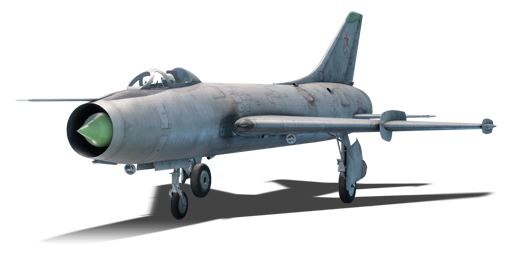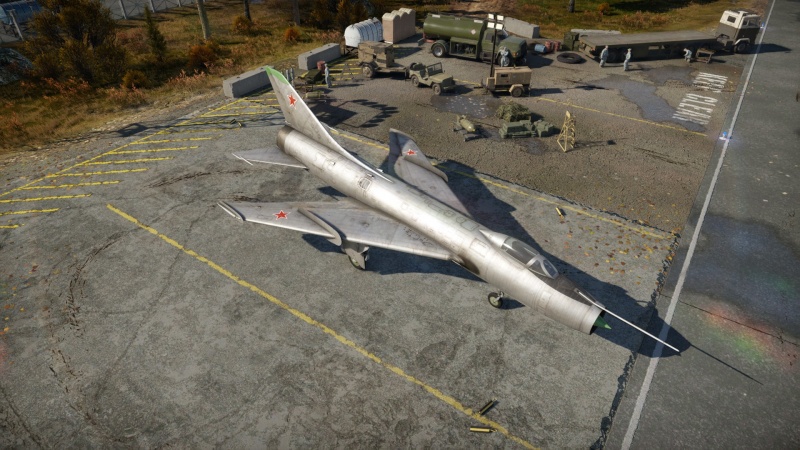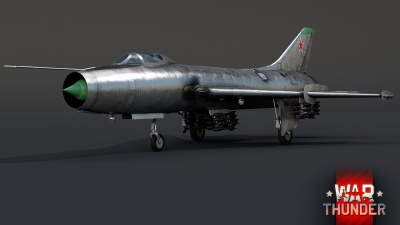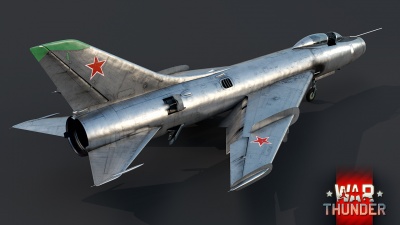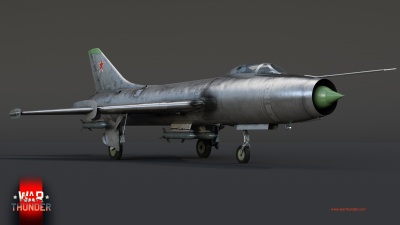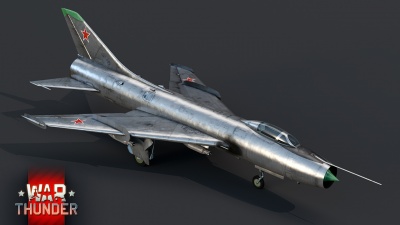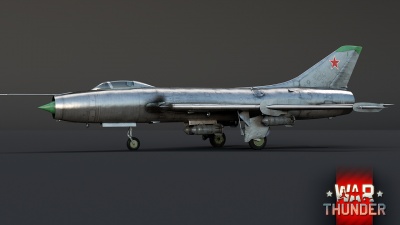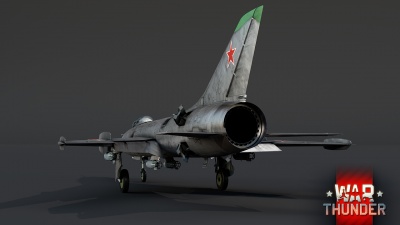Su-7B
Contents
Description
The Su-7B is a rank VI Soviet jet fighter with a battle rating of 9.3 (AB/RB) and 9.7 (SB). It was introduced in Update "Starfighters".
General info
Flight performance
The Su-7B is characterised by a low BR for a supersonic jet and amazing acceleration. With a 1-1 thrust-weight ratio when at optimal fuel load and spaded, it can reliably punch above its weight. The Sukhoi accelerates extremely well, outspeeding every supersonic at its BR except for MiG-21s. The manoeuvrability isn't bad, either - It can easily turn with supersonic aircraft such as MiG-21s, Harriers or A-7s. However, you must keep in mind that the plane has a tendency to break its wings if in a sustained 9+G turn at high speeds, and that you are not invulnerable while turning. You are giant, almost twice as big as a MiG-21, so be sure to not overstay your welcome in a dogfight and zoom away as soon as possible.
| Characteristics | Max Speed (km/h at 11,000 m) |
Max altitude (metres) |
Turn time (seconds) |
Rate of climb (metres/second) |
Take-off run (metres) | |||
|---|---|---|---|---|---|---|---|---|
| AB | RB | AB | RB | AB | RB | |||
| Stock | 2,161 | 2,145 | 19000 | 27.4 | 28.2 | 166.4 | 157.6 | 1,250 |
| Upgraded | 2,323 | 2,232 | 26.6 | 27.0 | 227.0 | 195.0 | ||
Details
| Features | |||||
|---|---|---|---|---|---|
| Combat flaps | Take-off flaps | Landing flaps | Air brakes | Arrestor gear | Drogue chute |
| X | X | ✓ | ✓ | X | ✓ |
| Limits | ||||||
|---|---|---|---|---|---|---|
| Wings (km/h) | Gear (km/h) | Flaps (km/h) | Max Static G | |||
| Combat | Take-off | Landing | + | - | ||
| 0 | 630 | N/A | N/A | 473 | ~11 | ~3 |
| Optimal velocities (km/h) | |||
|---|---|---|---|
| Ailerons | Rudder | Elevators | Radiator |
| < 700 | < 650 | < 600 | N/A |
Engine performance
| Engine | Aircraft mass | |||||
|---|---|---|---|---|---|---|
| Engine name | Number | Basic Mass | Wing loading (full fuel) | |||
| Saturn AL-7F-1-100 | 1 | 7,926 kg | 315 kg/m2 | |||
| Engine characteristics | Mass with fuel (no weapons load) | Max Takeoff Weight | ||||
| Weight (each) | Type | 8m fuel | 20m fuel | 27m fuel | ||
| 2,200 kg | Afterburning axial-flow turbojet | 8,756 kg | 10,000 kg | 10,726 kg | 13,043 kg | |
| Maximum engine thrust @ 0 m (RB / SB) | Thrust to weight ratio @ 0 m (WEP) | |||||
| Condition | 100% | WEP | 8m fuel | 20m fuel | 27m fuel | MTOW |
| Stationary | 5,848 kgf | 8,257 kgf | 0.94 | 0.83 | 0.77 | 0.63 |
| Optimal | 6,664 kgf (1,000 km/h) |
9,974 kgf (1,000 km/h) |
1.14 | 1.00 | 0.93 | 0.76 |
Survivability and armour
- 20 mm Aluminium Alloy - pilot's headrest
- 36 mm Aluminium Alloy - pilot's backrest
- 8 mm steel - cockpit front bulkhead
- 102 mm Bulletproof glass - Armoured windscreen
Modifications and economy
Armaments
Offensive armament
The Su-7B is armed with:
- 2 x 30 mm NR-30 cannons, wing-mounted (80 rpg = 160 total)
Suspended armament
The Su-7B can be outfitted with the following ordnance:
- Without load
- 64 x S-5K rockets
- 4 x S-24 rockets
- 28 x S-3K rockets
- 4 x 250 kg OFAB-250sv bombs (1,000 kg total)
- 4 x 500 kg FAB-500M-54 bombs (2,000 kg total)
Usage in battles
Build and maintain speed. Go for slow enemies and make sure to conserve your ammunition. A skilled pilot can easily get 3 to 4 kills with the 160 rounds of NR-30 ammo provided, but an unskilled pilot will have trouble hitting their shots. NR-30 cannons are (arguably) the best jet cannons one can have, and even a single hit can devastate an opponent. In conclusion, the Su-7B is a great plane, with amazing cannons and even better performance. Opponents will often underestimate you or even try to dogfight you.
Radars
The Su-7B is equipped with a SRD-5 rangefinding radar, located in the nose of the aircraft. It will automatically detect and lock on the other planes within the range. It is linked with a gyro gunsight and can help with aiming at close range.
| SRD-5 - Rangefinding radar | |||
|---|---|---|---|
| Maximum Detection Range |
Guaranteed Detection Range |
Max Azimuth Scan Angle |
Max Elevation Scan Angle |
| 3,000 m | 300 m | ±9° | ±9° |
Pros and cons
Pros:
- One of the fastest planes at its battle rating.
- Very fast acceleration.
- 2x 30 mm cannons are very powerful against ground and air targets alike.
- Decent energy retention.
- Time-fuzed S-24 rockets can be useful in head-ons.
Cons:
- Large silhouette, easy to hit.
- NR-30 cannons depletes ammunition quickly.
- No air-to-air missiles.
History
On May 14th 1953, shortly after Stalin's death and the reopening of the Sukhoi OKB, they began work on a swept-wing front-line fighter. Their first prototype was named S-1 and was fitted with the all-new Lyulka AL-7 turbojet. It was the first Soviet aircraft to utilize the all-moving tailplane and a translating centerbody, plus a dramatic wing sweep of 60°, irreversible hydraulically boosted controls, and an ejection seat of Sukhoi's own design. After the success of the S-1, production began with the S-2. later renamed the Su-7.
Later, on 31 July 1958, the Soviet Tactical Aviation tasked Sukhoi with developing a ground-attack variant of the Su-7, which could replace the scrapped Ilyushin IL-10. The resulting prototype, S-22, incorporated structural refinements for high-speed, low-altitude operations. It first flew in March 1959 and entered service in 1961 as the Su-7B.
Devblog
With the development of jet aviation, piston-engined attack aircraft quickly became an anachronism; a need arose for a new class of front-line aircraft - a fighter bomber. In the USSR, the MiG-15 and MiG-17 fighter jets were used to replace the piston-engined IL-10 to support the ground forces from the air, but it was quite obvious that a specialized machine was needed to fulfill the tasks of the fighter-bomber. The most suitable candidate was the Sukhoi Su-7 fighter jet, taken as the basis for the Su-7B fighter-bomber project. By the end of 1958, the first prototype was ready with the new AL-7F-1 engine. For almost two years, the aircraft underwent intensive testing and refinement, and in 1960 the new fighter-bomber went into mass production. Of the 431 planned, 344 Su-7Bs were built to equip up to 25 combat units. From the beginning of the 70’s, the Su-7B aircraft began to be replaced with more modern modifications and models.
Media
- Skins
- Images
- Videos
See also
Links to the articles on the War Thunder Wiki that you think will be useful for the reader, for example:
- reference to the series of the aircraft;
- links to approximate analogues of other nations and research trees.
External links
| Sukhoi Design Bureau (Сухого Опытное конструкторское бюро) | |
|---|---|
| Jet fighters | Su-9 · Su-11 |
| Su-27 | Su-27 · Su-27SM |
| Strike aircraft | |
| Su-2 | BB-1 · Su-2 (M-82) · Su-2 MV-5 · Su-2 TSS-1 |
| Su-6 | Su-6 · Su-6 (AM-42) · Su-6 (M-71F) |
| Su-7 | Su-7B · Su-7BKL · Su-7BMK |
| Su-8 | Su-8 |
| Su-17 | Su-17M2 · Su-17M4 · Su-22M3 |
| Su-24 | Su-24M |
| Su-25 | Su-25 · Su-25BM · Su-25K · Su-25T · Su-25SM3 · Su-39 |
| Su-34 | Su-34 |
| Export | ◊Su-22UM3K · ◔Su-22M3 · ◊Su-22M4 · ◄Su-22M4 WTD61 |
| J-11* | |
| *CKD and SKD kits assembled by Shenyang Aircraft Corporation | |
| USSR jet aircraft | |
|---|---|
| Bereznyak-Isayev | BI |
| Yakovlev | Yak-15 · Yak-15P · Yak-17 · Yak-23 · Yak-28B · Yak-30D · Yak-38 · Yak-38M · Yak-141 |
| Mikoyan-Gurevich | MiG-9 · MiG-9 (l) · MiG-15 · MiG-15bis · MiG-15bis ISh · MiG-17 · MiG-17AS · MiG-19PT |
| MiG-21F-13 · MiG-21PFM · MiG-21S (R-13-300) · MiG-21SMT · MiG-21bis | |
| MiG-23M · MiG-23ML · MiG-23MLD · MiG-27M · MiG-27K | |
| MiG-29 · MiG-29SMT | |
| Lavochkin | La-174 · La-15 · La-200 |
| Sukhoi | Su-9 · Su-11 |
| Su-7B · Su-7BKL · Su-7BMK · Su-17M2 · Su-17M4 · Su-22M3 | |
| Su-24M | |
| Su-25 · Su-25BM · Su-25K · Su-25T · Su-25SM3 · Su-39 | |
| Su-27 · Su-27SM | |
| Su-34 | |
| Ilyushin | IL-28 · IL-28Sh |
| Tupolev | Tu-14T |


